Microwave Soil Heating with Evanescent Fields from Slow-Wave Comb and Ceramic Applicators
Abstract
1. Introduction
2. Theoretical Assessment of the Applicator Systems
2.1. Comb Slow-Wave Structures
2.2. Frustrated Total Internal Reflections (Dielectric Block) Structures
3. Materials and Methods
- MC = 32%, density = 586 kg m−3
- MC = 89%, density = 710 kg m−3
- MC = 174%, density = 1070 kg m−3
4. Results
4.1. Temperature Distribution in the Soil by the Comb Slow-Wave Applicator (2.45 GHz)
4.2. Temperature Distribution in the Soil by Ceramic Applicator (2.45 GHz)
5. Discussion
6. Conclusions
7. Patents
Author Contributions
Funding
Data Availability Statement
Conflicts of Interest
Nomenclature
| Symbol | Description |
| Aq | Amplitude of qth resonant wave across the width of the FTIR dielectric resonator |
| As | Width of the applicator in the y-direction (m) |
| Bl | Amplitude of lth resonant wave in the height of the FTIR dielectric resonator |
| c | Speed of light in a vacuum (m s−1) |
| Cm | Amplitude of mth resonant wave along the length of the FTIR dielectric resonator |
| Cp | Thermal capacity of the soil (J kg−1 °C−1) |
| DC | Dielectric constant of a material |
| d | Depth of the comb teeth (m) |
| Eo | Field amplitude (V m−1) |
| Ed | Thermal energy deposited into the soil during microwave heating between the soil surface and a known depth d metres into the soil (J) |
| Et | Thermal energy deposited into the soil during microwave heating (J) |
| f | Frequency (Hz) |
| h | Coefficient of convective heat transfer at the surface of the dielectric material (W m−2 K−1) |
| k | Wave number of the microwave fields in the free space between the teeth of the comb slow-wave structure (m−1) |
| L | Length of the applicator (m) |
| Lwater | Latent heat of vaporisation for water (J kg−1) |
| MC | Moisture content of the soil (on a dry weight basis) |
| n | In Equations (3) and (10) is the scaling factor, which accounts for simultaneous heat and moisture movement in heated material [28] |
| n1 | Refractive index of dielectric block inside resonant cavity |
| n2 | Refractive index of dielectric material adjacent to FTIR applicator dieelctric block |
| q, l and m | Mode numbers for the electromagnetic field in a resonant cavity |
| To | The initial temperature of the dielectric material (°C) |
| λₒ | Wavelength in vacuum or in air (m) |
| T | Period of the comb slow-wave teeth (m) |
| α | Wave attenuation factor in the soil (m−1) |
| β | Phase velocity (m s−1) |
| εo | Electrical permittivity of free space |
| γ | Thermal diffusivity of the dielectric material (m2 s−1) Note: |
| κ’ | Dielectric constant of the space adjacent to the Comb slow-wave structure |
| κ” | Dielectric loss factor of the dielectric material |
| λ | Wavelength of the electromagnetic fields (m) |
| ρ | Soil density (kg m−3) |
| τ | Evanescent field decay rate for the comb slow-wave or FTIR structure (m−1) |
| τ2 | Evanescent field decay rate in soil for the comb slow-wave structure, when the comb is covered by a dielectric material (m−1) |
| ω | Angular frequency (Rad s−1) |
| θ | Angle of incidence of an electromagnetic wave encountering a boundary of a dielectric material, measured relative to the normal of the surface of the dielectric block, for the FTIR electromagnetic field (Radians) |
| χ | Thermal conductivity of the dielectric material (W m−1 K−1) |
| Unit vector perpendicular to the surface of the comb | |
| Unit vector along the surface of the comb in the direction of field propagation |
References
- Velazquez-Marti, B.; Gracia-Lopez, C.; Marzal-Domenech, A. Germination Inhibition of Undesirable Seed in the Soil using Microwave Radiation. Biosyst. Eng. 2006, 93, 365–373. [Google Scholar] [CrossRef]
- Davis, F.S.; Wayland, J.R.; Merkle, M.G. Ultrahigh-Frequency Electromagnetic Fields for Weed Control: Phytotoxicity and Selectivity. Science 1971, 173, 535–537. [Google Scholar] [CrossRef] [PubMed]
- Davis, F.S.; Wayland, J.R.; Merkle, M.G. Phytotoxicity of a UHF Electromagnetic Field. Nature 1973, 241, 291–292. [Google Scholar] [CrossRef]
- Wayland, J.R.; Davis, F.S.; Merkle, M.G. Vegetation Control. U.S. Patent Office 4092800, 30 July 1978. [Google Scholar]
- Wayland, J.; Merkle, M.; Davis, F.; Menges, R.M.; Robinson, R. Control of weeds with UHF electromagnetic fields. Weed Res. 1975, 15, 1–5. [Google Scholar] [CrossRef]
- Falciglia, P.P.; Vagliasindi, F.G.A. Techno-economic analysis of hydrocarbon-polluted soil treatment by using ex situ microwave heating: Influence of soil texture and soil moisture on electric field penetration, operating conditions and energy costs. J. Soils Sediments 2016, 16, 1330–1344. [Google Scholar] [CrossRef]
- Barker, A.V.; Craker, L.E. Inhibition of Weed Seed Germination by Microwaves. Agron. J. 1991, 83, 302–305. [Google Scholar] [CrossRef]
- Diprose, M.F.; Benson, F.A.; Willis, A.J. The Effect of Externally Applied Electrostatic Fields, Microwave Radiation and Electric Currents on Plants and Other Organisms, with Special Reference to Weed Control. Bot. Rev. 1984, 50, 171–223. [Google Scholar] [CrossRef]
- Khan, M.J.; Jurburg, S.D.; He, J.; Brodie, G.; Gupta, D. Impact of microwave disinfestation treatments on the bacterial communities of no-till agricultural soils. Eur. J. Soil Sci. 2019, 71, 1006–1017. [Google Scholar] [CrossRef]
- Mahdi, W.M.; Al-Badri, K.S.L.; Al-Samarrai, G.F. Use of Microwave Radiation in Soil Sterilization and Effects on the Bacteria, Fungi and Growth Characteristics of Chickpea Plant (Cicer arietinum L.). Plant Arch. 2019, 19, 2064–2069. [Google Scholar]
- Brodie, G.; Khan, M.J.; Gupta, D. Microwave Soil Treatment and Plant Growth. In Sustainable Crop Production; Filho, M.C.M.T., Hasanuzzaman, M., Eds.; IntechOpen: London, UK, 2019. [Google Scholar] [CrossRef]
- Mahdi, W.M.; Al-Badri, K.S.L.; Alqaisi, M.R.M. Effect of Microwave Radiation on Bacteria, Fungi and Some Growth Characteristics of Cowpea Vigna unguiculata L. Gesunde Pflanzen 2020, 73, 161–167. [Google Scholar] [CrossRef]
- Metaxas, A.C.; Meredith, R.J. Industrial Microwave Heating; Peter Peregrinus: London, UK, 1983. [Google Scholar]
- Shibakova, V.S. On the possibility of using microwave energy for soil stabilization. Bull. Int. Assoc. Eng. Geol. 1975, 12, 89–91. [Google Scholar] [CrossRef]
- De Wilde, M.; Buisson, E.; Yavercovski, N.; Willm, L.; Bieder, L.; Mesléard, F. Using Microwave Soil Heating to Inhibit Invasive Species Seed Germination. Invasive Plant Sci. Manag. 2017, 10, 262–270. [Google Scholar] [CrossRef]
- Tongsheng, S. Directivity factor of coupled antennas for microwave heating of asphalt mixture. Int. J. Appl. Electromagn. Mech. 2016, 50, 647–663. [Google Scholar] [CrossRef]
- Mavrogianopoulos, G.N.; Frangoudakis, A.; Pandelakis, J. Energy Efficient Soil Disinfestation by Microwaves. J. Agric. Eng. Res. 2000, 75, 149–153. [Google Scholar] [CrossRef]
- Cooper, A.P.; Brodie, G. The effect of microwave radiation and soil depth on soil pH, N, P, K, SO4 and bacterial colonies. Plant Prot. Q. 2009, 24, 67–70. [Google Scholar]
- Chauhan, B.S.; Gill, G.; Preston, C. Influence of tillage systems on vertical distribution, seedling recruitment and persistence of rigid ryegrass (Lolium rigidum) seed bank. Weed Sci. 2006, 54, 669–676. [Google Scholar] [CrossRef]
- Sinclair, K.I.; Goussetis, G.; Desmulliez, M.P.Y.; Sangster, A.J.; Tilford, T.; Bailey, C.; Parrott, A.K. Optimization of an Open-Ended Microwave Oven for Microelectronics Packaging. IEEE Trans. Microw. Theory Tech. 2008, 56, 2635–2641. [Google Scholar] [CrossRef]
- Cronin, N.J. Microwave and Optical Waveguides; J W Arrowsmith Ltd.: Bristol, UK, 1995. [Google Scholar]
- Dunn, D.A. Slow wave couplers for microwave dielectric heating systems. J. Microw. Power 1967, 2, 7–20. [Google Scholar] [CrossRef]
- Pchelnikov, Y.N. Features of slow waves and potentials for their nontraditional application. Appl. Radiotech. Electron. Bioligy Med. 2003, 48, 450–462. [Google Scholar]
- Pchelnikov, Y.N.; Yelizarov, A.A. Medical application of slow electromagnetic waves. In Proceedings of the Electronics and Radiophysics of Ultra-High Frequencies, Saint Petersburg, Russia, 24–28 May 1999; pp. 464–467. [Google Scholar]
- Chen, F.S. The Comb-Type Slow-Wave Structure for TWM Applications. Bell Syst. Tech. J. 1964, 43, 1035–1066. [Google Scholar] [CrossRef]
- Pchelnikov, Y.N.; Kholodnyi, V.A. Medical application of surface electromagnetic waves. Bioelectrochem. Bioenergy 1998, 47, 283–290. [Google Scholar] [CrossRef]
- Brodie, G.; Pchelnikov, Y.; Torgovnikov, G. Development of Microwave Slow-Wave Comb Applicators for Soil Treatment at Frequencies 2.45 and 0.922 GHz (Theory, Design, and Experimental Study). Agriculture 2020, 10, 604. [Google Scholar] [CrossRef]
- Brodie, G. Simultaneous heat and moisture diffusion during microwave heating of moist wood. Appl. Eng. Agric. 2007, 23, 179–187. [Google Scholar] [CrossRef]
- Van Remmen, H.H.J.; Ponne, C.T.; Nijhuis, H.H.; Bartels, P.V.; Herkhof, P.J.A.M. Microwave Heating Distribution in Slabs, Spheres and Cylinders with Relation to Food Processing. J. Food Sci. 1996, 61, 1105–1113. [Google Scholar] [CrossRef]
- Meredith, R. Engineers’ Handbook of Industrial Microwave Heating; The Institute of Electrical Engineers: Stevenage, UK, 1998. [Google Scholar]
- Eremenko, Z.E. The Electromagnetic Wave Propagation on the Interface between Low and High Loss Dielectrics. Adv. Condens. Matter Phys. 2010, 2010, 683521. [Google Scholar] [CrossRef][Green Version]
- Khattak, H.K.; Bianucci, P.; Slepkov, A.D. Linking plasma formation in grapes to microwave resonances of aqueous dimers. Proc. Natl. Acad. Sci. USA 2019, 116, 4000–4005. [Google Scholar] [CrossRef]
- Han, J.Y.; Kollin, J.S.; Slobodin, D.E. Touch Sensing with Frustrated Total Internal Reflection. U.S. Patent 8,736,581, 27 May 2014. [Google Scholar]
- Niederauer, C.; Blumhardt, P.; Mücksch, J.; Heymann, M.; Lambacher, A.; Schwille, P. Direct characterization of the evanescent field in objective-type total internal reflection fluorescence microscopy. Opt. Express 2018, 26, 20492–20506. [Google Scholar] [CrossRef]
- Taheri, S.; Brodie, G.; Jacob, M.V.; Antunes, E. Dielectric properties of chickpea, red and green lentil in the microwave frequency range as a function of temperature and moisture content. J. Microw. Power Electromagn. Energy 2018, 52, 198–214. [Google Scholar] [CrossRef]
- Sipahioglu, O.; Barringer, S.A. Dielectric properties of vegetables and fruits as a function of temperature, ash, and moisture content. J. Food Sci. 2003, 68, 234–239. [Google Scholar] [CrossRef]
- Mironov, V.; Savin, I. A temperature-dependent multi-relaxation spectroscopic dielectric model for thawed and frozen organic soil at 0.05–15 GHz. Phys. Chem. Earth Parts A/B/C 2015, 83, 57–64. [Google Scholar] [CrossRef]
- Kabir, M.F.; Daud, W.M.; Khalid, K.B.; Sidek, H.A.A. Temperature dependence of the dielectric properties of rubber wood. Wood Fiber Sci. 2001, 33, 233–238. [Google Scholar]
- Brodie, G. Modeling the very broad band dielectric properties of water. J. Microw. Power Electromagn. Energy 2021, 55, 80–89. [Google Scholar] [CrossRef]
- Yee, K.S. Numerical solution of initial boundary value problems involving Maxwell’s equations in isotropic media. IEEE Trans. Antennas Propag. 1966, 14, 302–307. [Google Scholar]
- Israelsen, O.W.; West, F.L. Water Holding Capacity of Irrigated Soils; Utah Agricultural College: Logan, UT, USA, 1922; pp. 1–24. [Google Scholar]
- Oyeyemia, K.D.; Sanuade, O.A.; Oladunjoye, M.A.; Aizebeokhai, A.P.; Olaojo, A.A.; Fatoba, J.O.; Olofinnade, O.M.; Ayara, W.A.; Oladapo, O. Data on the thermal properties of soil and its moisture content. Data Brief 2018, 17, 900–906. [Google Scholar] [CrossRef]
- Richards, L.A.; Weaver, L.R. Moisture retention by some irrigated soils as related to soil moisture tension. J. Agric. Res. 1944, 69, 215–235. [Google Scholar]
- Kabir, H.; Khan, M.J.; Brodie, G.; Gupta, D.; Pang, A.; Jacob, M.V.; Antunes, E. Measurement and modelling of soil dielectric properties as a function of soil class and moisture content. J. Microw. Power Electromagn. Energy 2020, 54, 3–18. [Google Scholar] [CrossRef]
- Abdelh, S. An Advanced Review of Thermodynamics of Electromagnetism. Int. J. Res. Stud. Sci. Eng. Technol. 2016, 3, 10–25. [Google Scholar]
- Meredith, R.J. A three axis model of the mode structure of multimode cavities. J. Microw. Power Electromagn. Energy 1994, 29, 31–44. [Google Scholar] [CrossRef]
- Trabelsi, S.; Nelson, S.O. Microwave moisture meter for granular and particulate materials. Proceedings of Instrumentation and Measurement Technology Conference (I2MTC), Austin, TX, USA, 3–6 May 2010; pp. 1304–1308. [Google Scholar]
- Verbitskii, I.L. Dispersion-relations for comb-type slow-wave structures. IEEE Trans. Microw. Theory Tech. 1980, 28, 48–50. [Google Scholar] [CrossRef]
- Curtis, J.O. Moisture Effects on the Dielectric Properties of Soils. IEEE Trans. Geosci. Remote Sens. 2001, 39, 125–128. [Google Scholar] [CrossRef]
- Holman, J.P. Heat Transfer, 10th ed.; McGraw-Hill: New York, NY, USA, 1997. [Google Scholar]
- Nidal, H.A.-H. Thermal Properties of Soils as affected by Density and Water Content. Biosyst. Eng. 2003, 86, 97–102. [Google Scholar] [CrossRef]
- Velázquez-Martí, B.; Gracia-López, C.; Plaza-Gonzalez, P.J. Determination of Dielectric Properties of Agricultural Soil. Biosyst. Eng. 2005, 91, 119–125. [Google Scholar] [CrossRef]
- Dobson, M.C.; Ulaby, F.T.; Hallikainen, M.T.; El-rayes, M.A. Microwave Dielectric Behavior of Wet Soil-Part II: Dielectric Mixing Models. IEEE Trans. Geosci. Remote Sens. 1985, GE-23, 35–46. [Google Scholar] [CrossRef]
- Al-Shamma’a, A.I.; Wylie, S.R.; Lucas, J.; Pau, C.F. Design and construction of a 2.45 GHz waveguide-based microwave plasma jet at atmospheric pressure for material processing. J. Phys. D Appl. Phys. 2001, 34, 2734–2741. [Google Scholar] [CrossRef]
- Brodie, G.; Torkovnikov, G.; Farrell, P. Microwave Application Method and Apparatus. AU Patent 2016905272, 20 December 2016. [Google Scholar]
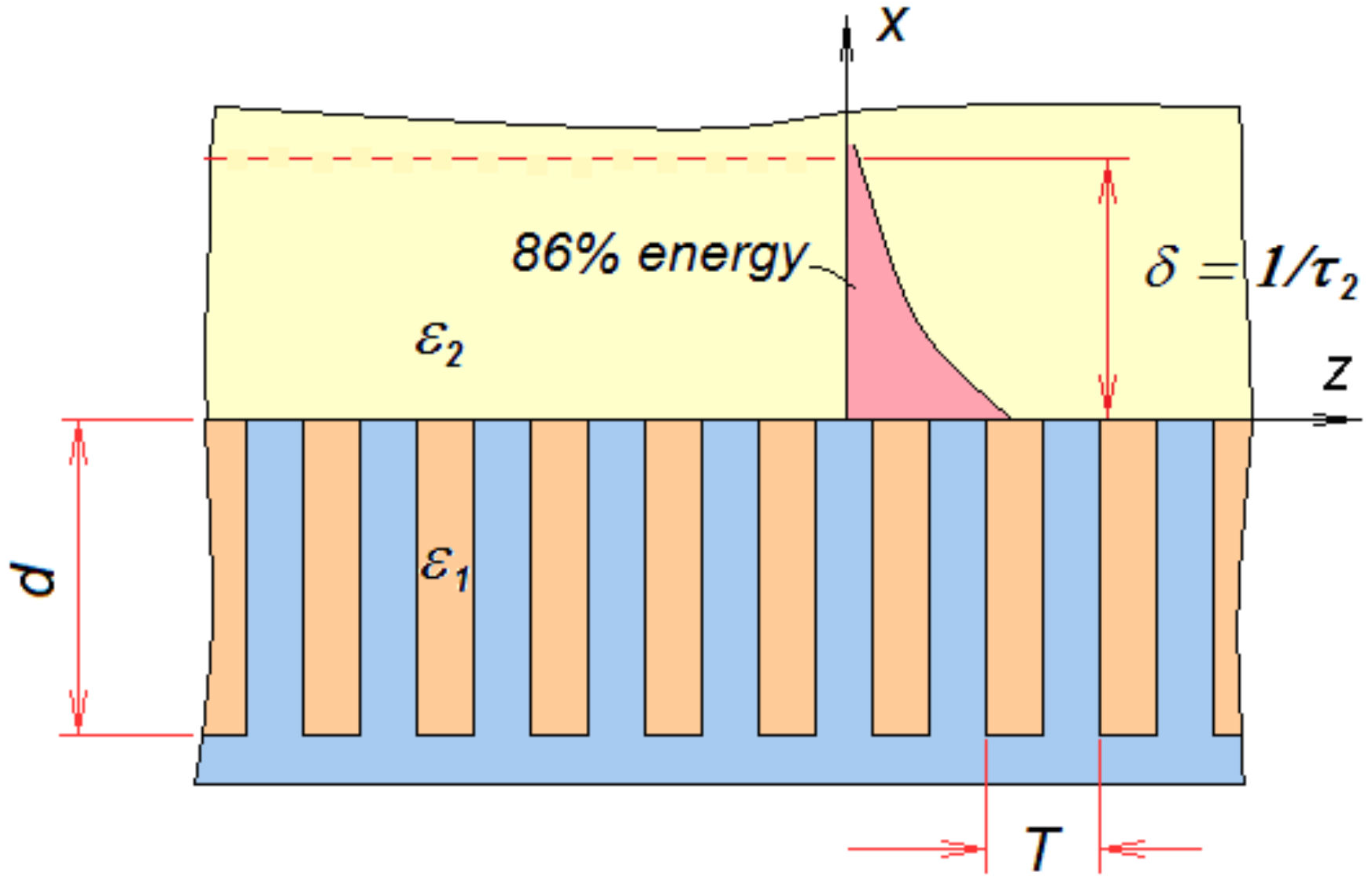


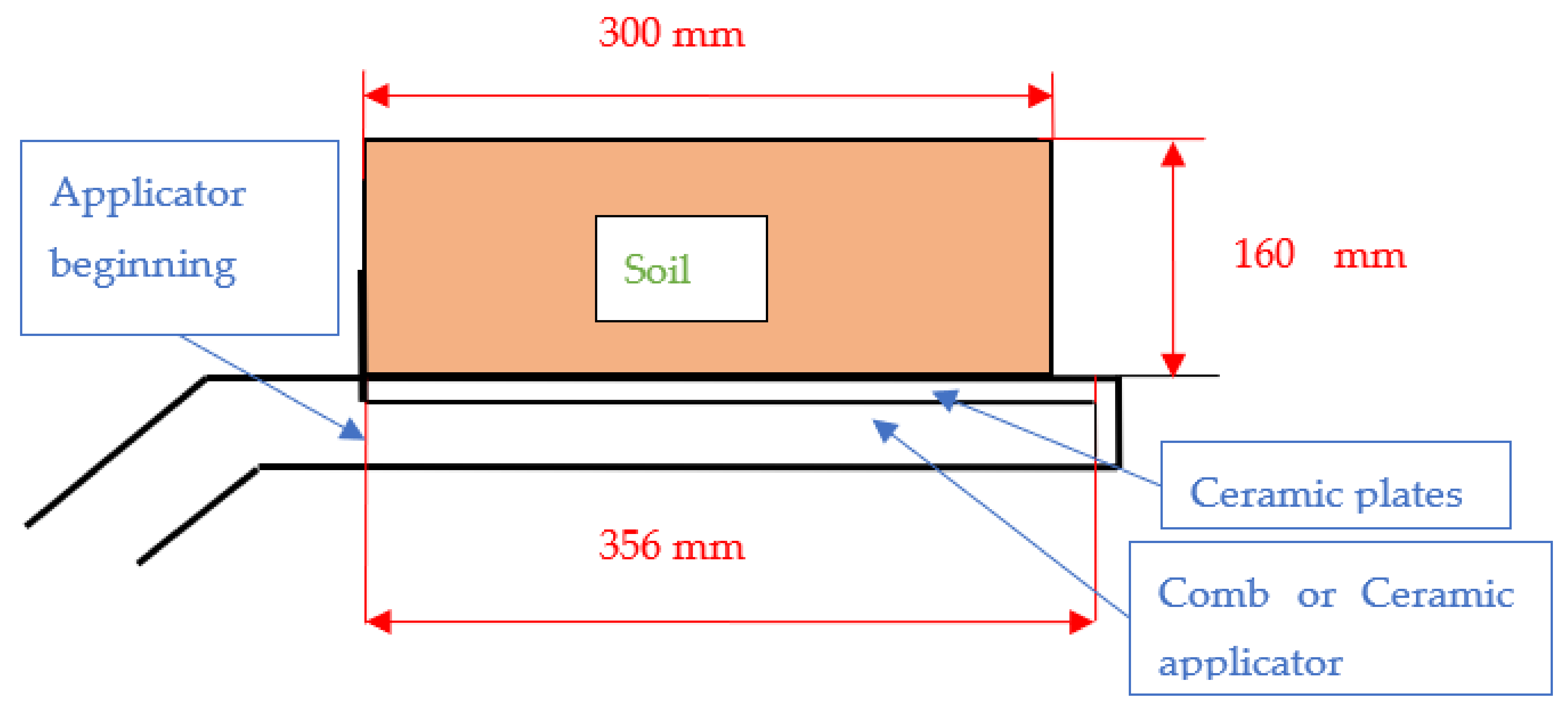
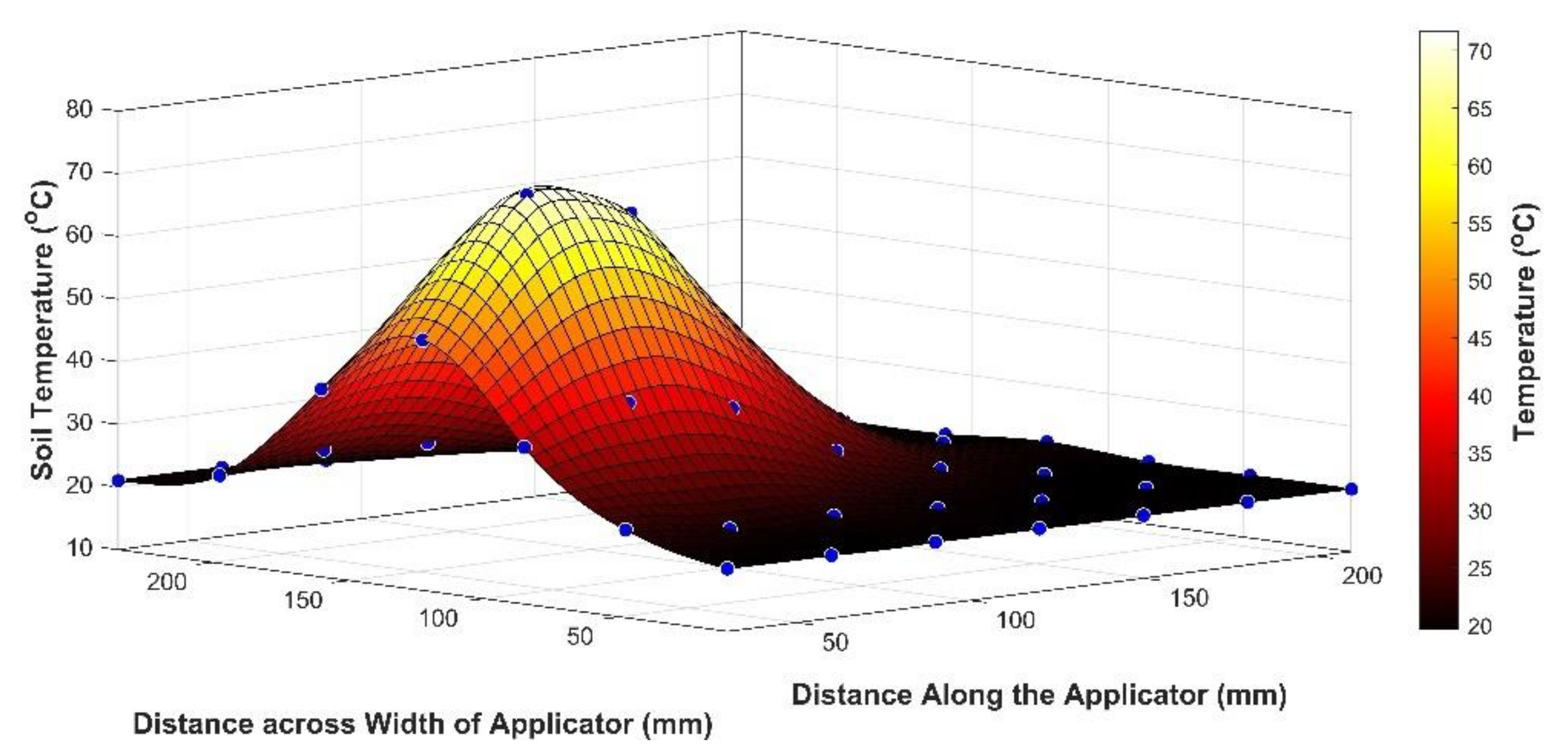
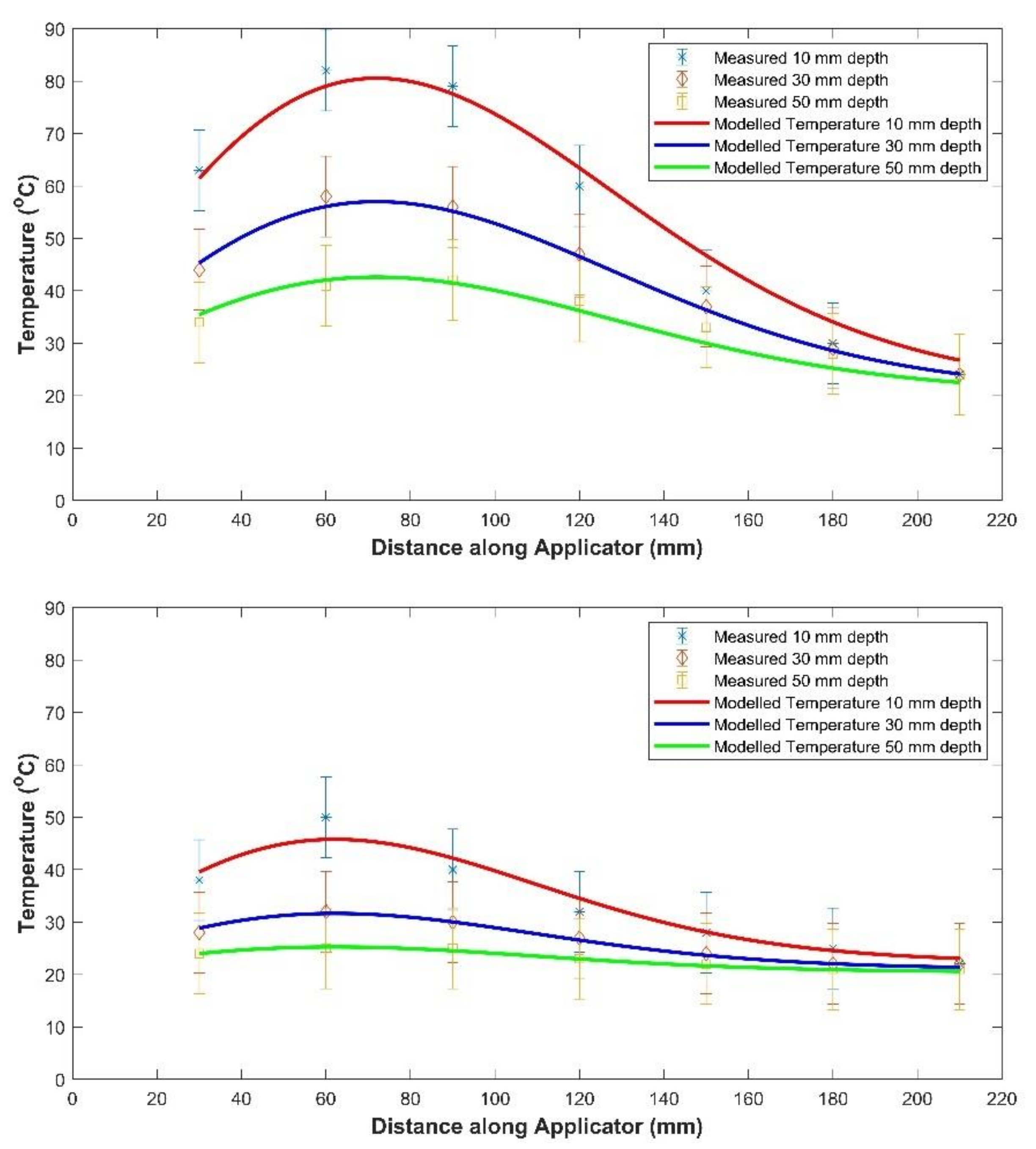
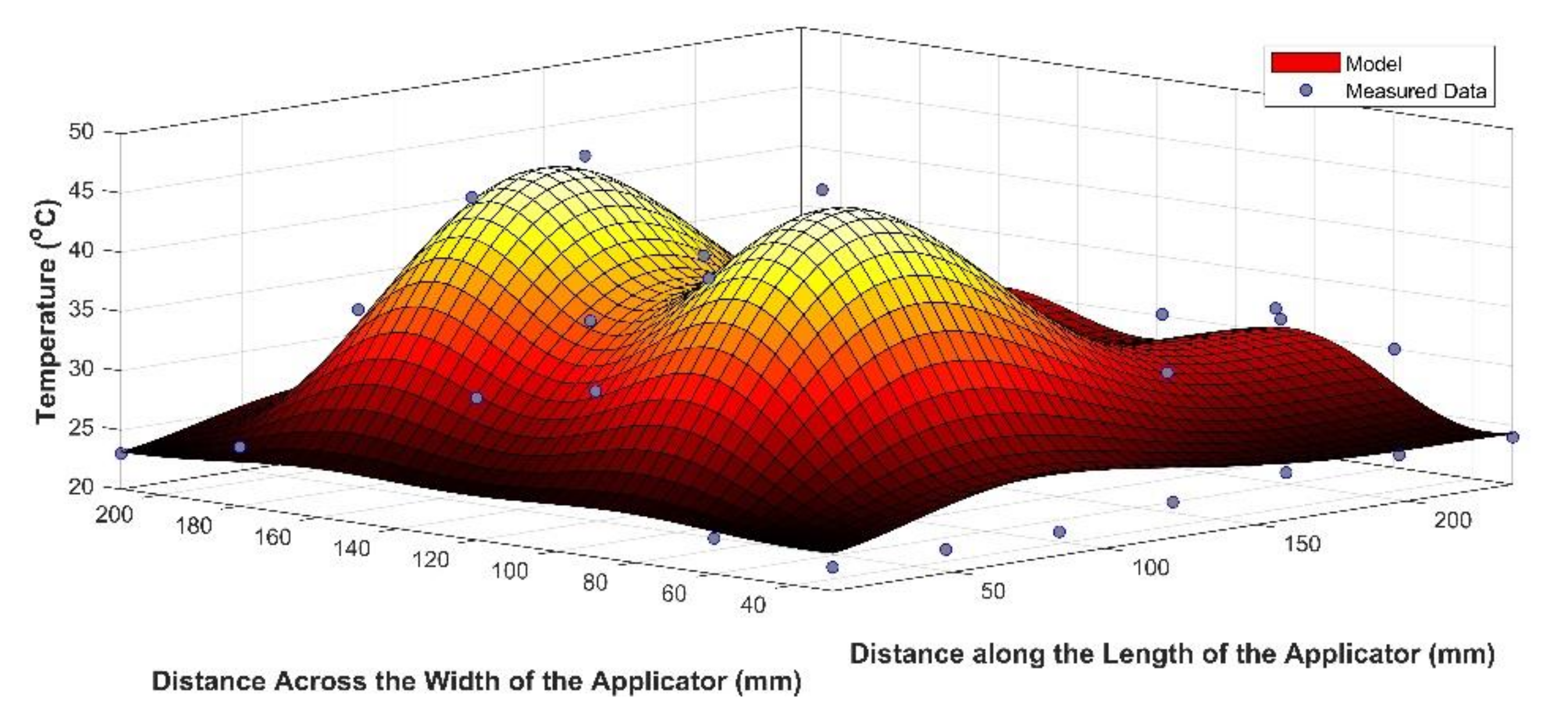
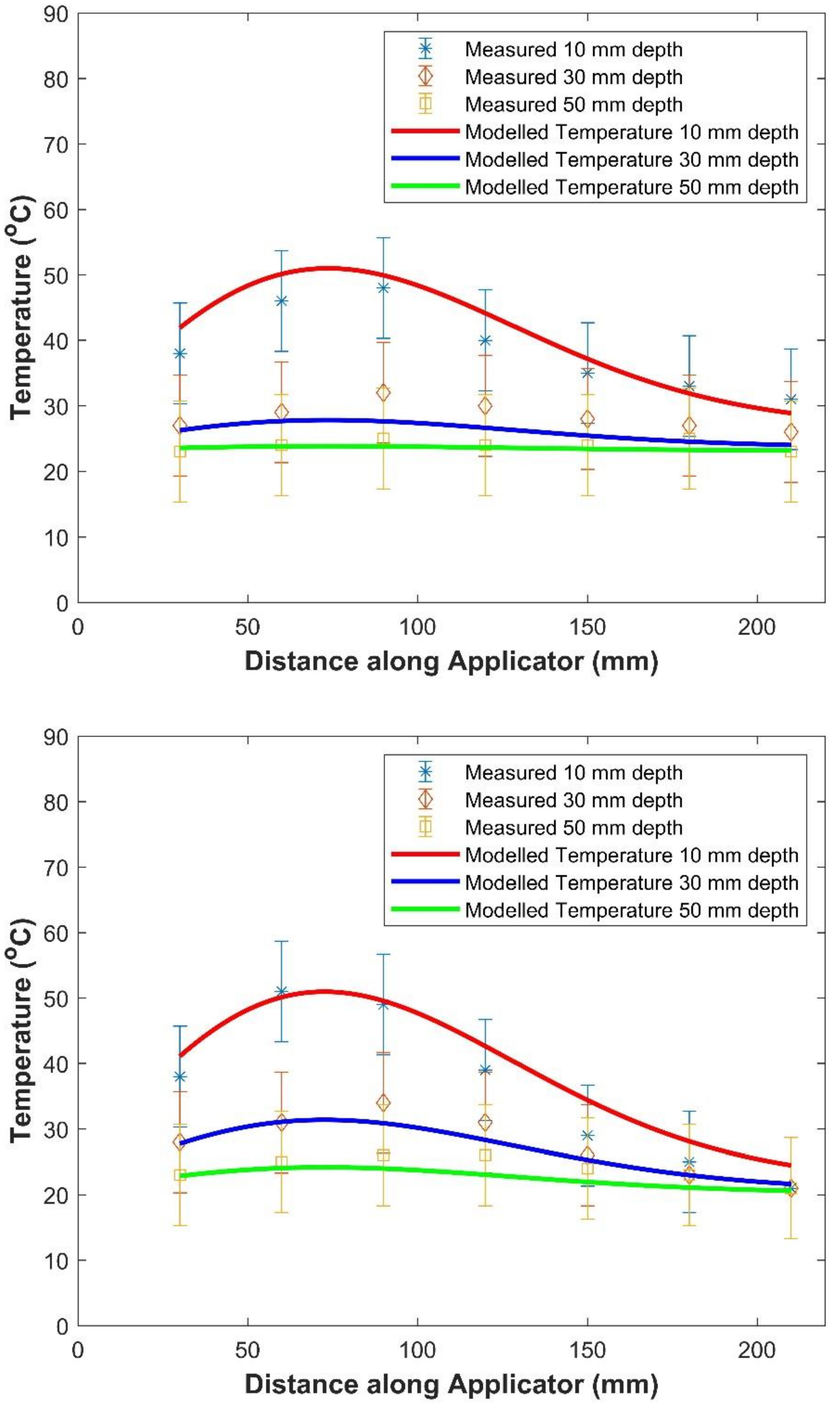
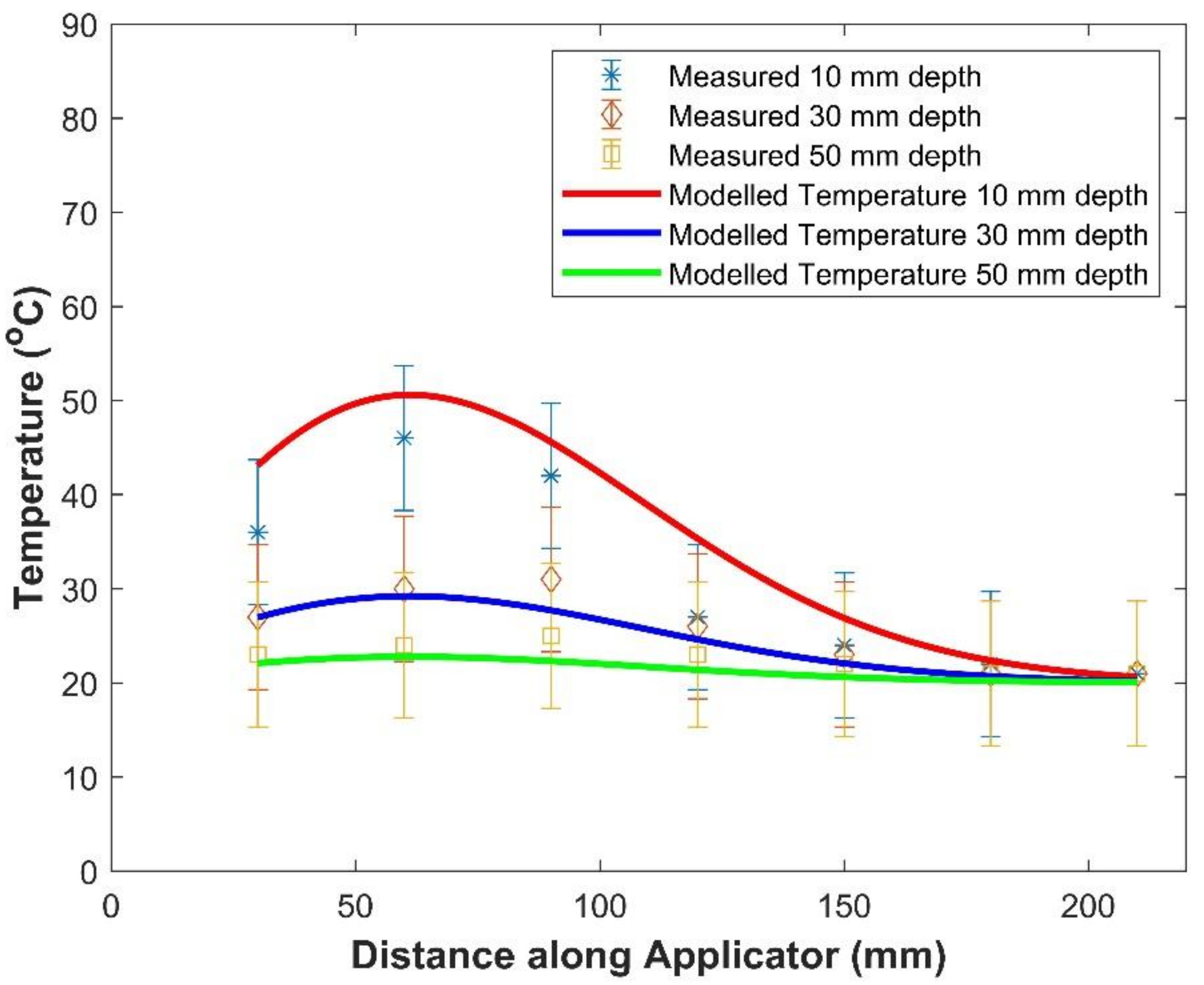

| Parameters | FTIR Ceramic (mm) | Slow-Wave Comb (mm) |
|---|---|---|
| Working length | 356 | 356 |
| Applicator thickness | 23 | 23 |
| Ceramic slab thickness | 13 | |
| Applicator width | 150 | 150 |
| Comb electrode width | 100 | |
| Ceramic slab width | 100 | |
| Comb electrode thickness | 16 | |
| Comb electrode conic length | 185 | |
| Grove depth/width | 13/3 | |
| Comb tooth thickness | 3 | |
| Ceramic plates covering applicators for both applicators | Alumina (99%) ceramic plate size 3 mm × 84 mm × 146 mm (4 pieces), (DC = 9.8, loss tangent 0.0002) | |
| Parameter | Soil Condition (MC %) | Value |
|---|---|---|
| α | 32 | 1.3 ± 0.06 m−1 |
| 174 | 3.4 ± 0.26 m−1 | |
| τ | 32 | 17.6 ± 0.7 m−1 |
| 174 | 19.9 ± 1.5 m−1 | |
| γ | 32 | 1.82 ± 0.08 × 10−4 m2 s−1 |
| 174 | 1.32 ± 0.1 × 10−4 m2 s−1 |
| Parameter | Soil Condition (MC %) | Value |
|---|---|---|
| α | 32 | 1.3 ± 0.06 m−1 |
| 174 | 3.4 ± 0.26 m−1 | |
| τ | 32 | 44.0 ± 0.7 m−1 |
| 174 | 30 ± 1.2 m−1 | |
| γ | 32 | 1.82 ± 0.08 × 10−4 m2 s−1 |
| 174 | 1.32 ± 0.1 × 10−4 m2 s−1 | |
| A1 | 0.83 ± 0.04 | |
| A2 | 0.0 | |
| A3 | 0.63 ± 0.03 | |
| C1 | 0.4 ± 0.016 | |
| C2 | 0.34 ± 0.016 |
Publisher’s Note: MDPI stays neutral with regard to jurisdictional claims in published maps and institutional affiliations. |
© 2022 by the authors. Licensee MDPI, Basel, Switzerland. This article is an open access article distributed under the terms and conditions of the Creative Commons Attribution (CC BY) license (https://creativecommons.org/licenses/by/4.0/).
Share and Cite
Brodie, G.; Torgovnikov, G. Microwave Soil Heating with Evanescent Fields from Slow-Wave Comb and Ceramic Applicators. Energies 2022, 15, 1068. https://doi.org/10.3390/en15031068
Brodie G, Torgovnikov G. Microwave Soil Heating with Evanescent Fields from Slow-Wave Comb and Ceramic Applicators. Energies. 2022; 15(3):1068. https://doi.org/10.3390/en15031068
Chicago/Turabian StyleBrodie, Graham, and Grigory Torgovnikov. 2022. "Microwave Soil Heating with Evanescent Fields from Slow-Wave Comb and Ceramic Applicators" Energies 15, no. 3: 1068. https://doi.org/10.3390/en15031068
APA StyleBrodie, G., & Torgovnikov, G. (2022). Microwave Soil Heating with Evanescent Fields from Slow-Wave Comb and Ceramic Applicators. Energies, 15(3), 1068. https://doi.org/10.3390/en15031068






